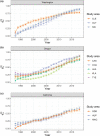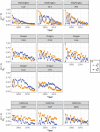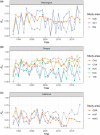Range-wide sources of variation in reproductive rates of northern spotted owls
- PMID: 36053865
- PMCID: PMC10078374
- DOI: 10.1002/eap.2726
Range-wide sources of variation in reproductive rates of northern spotted owls
Abstract
We conducted a range-wide investigation of the dynamics of site-level reproductive rate of northern spotted owls using survey data from 11 study areas across the subspecies geographic range collected during 1993-2018. Our analytical approach accounted for imperfect detection of owl pairs and misclassification of successful reproduction (i.e., at least one young fledged) and contributed further insights into northern spotted owl population ecology and dynamics. Both nondetection and state misclassification were important, especially because factors affecting these sources of error also affected focal ecological parameters. Annual probabilities of site occupancy were greatest at sites with successful reproduction in the previous year and lowest for sites not occupied by a pair in the previous year. Site-specific occupancy transition probabilities declined over time and were negatively affected by barred owl presence. Overall, the site-specific probability of successful reproduction showed substantial year-to-year fluctuations and was similar for occupied sites that did or did not experience successful reproduction the previous year. Site-specific probabilities for successful reproduction were very small for sites that were unoccupied the previous year. Barred owl presence negatively affected the probability of successful reproduction by northern spotted owls in Washington and California, as predicted, but the effect in Oregon was mixed. The proportions of sites occupied by northern spotted owl pairs showed steep, near-monotonic declines over the study period, with all study areas showing the lowest observed levels of occupancy to date. If trends continue it is likely that northern spotted owls will become extirpated throughout large portions of their range in the coming decades.
Keywords: barred owl; detection; misclassification; multistate; nondetection; occupancy; reproductive rate; spotted owl.
© 2022 The Authors. Ecological Applications published by Wiley Periodicals LLC on behalf of The Ecological Society of America.
Conflict of interest statement
The authors declare no conflict of interest.
Figures




References
-
- Anderson, D. R. , Burnham K. P., Franklin A. B., Gutiérrez R. J., Forsman E. D., Anthony R. G., White G. C., and Shenk T. M.. 1999. “A Protocol for Conflict Resolution in Analyzing Empirical Data Related to Natural Resource Controversies.” Wildlife Society Bulletin 27: 1050–8.
-
- Anthony, R. G. , Forsman E. D., Franklin A. B., Anderson D. R., Burnham K. P., White G. C., Schwarz C. J., et al. 2006. “Status and Trends in Demography of Northern Spotted Owls, 1985–2003.” Wildlife Monographs 163: 1–48.
-
- Bailey, L. L. , Reid J. A., Forsman E. D., and Nichols J. D.. 2009. “Modeling Co‐Occurrence of Northern Spotted and Barred Owls: Accounting for Detection Probability Differences.” Biological Conservation 142: 2983–9.
-
- Blackburn, T. M. , Bellard C., and Ricciardi A.. 2019. “Alien Versus Native Species as Drivers of Recent Extinctions.” Frontiers in Ecology and Environment 17: 203–7.
-
- Burnham, K. P. , and Anderson D. R.. 2002. Model Selection and Multimodel Inference: A Practical Information‐Theoretic Approach, 2nd ed. New York, NY: Springer‐Verlag.
Publication types
MeSH terms
LinkOut - more resources
Full Text Sources

